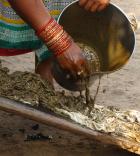Custom Search 1
Small Study and Research Grant (India)

Study and documentation of the Sapthasthanam (seven sacred spaces) of Chhakavapalli in Thanjavur District

A project to devise a "living tribal museum" in Thane.

A museological study of cultic objects related with asadaar

A survey of British oil paintings on canvas in museums and government and secular organisations in Tamilnadu

Indian cattle in the light of Neolithic and Chalcolithic rock art

Tribal Kotpad textiles and the methods of natural dyeing in the border zone of Orissa and Bastar

Documentation of the conservation needs of historical monuments in Pandua, West Bengal

A study of the history and conservation needs of the monument Sarsota, at Sahaswan, District Budaun, Uttar Pradesh

Review of the Harappan Culture in North-western Maharashtra: Cataloging a database
It has generally been suggested that the migration of the Harappan people ended in the Indus-Saraswati divide at Gujarat. Further study supported by the Nehru Trust has provided strong evidence to suggest that Harappan Culture moved considerably further beyond Gujarat and indeed spread deep into the Deccan (North-western region of Maharashtra). Although Harappan culture underwent significant changes during this period, identifiable practices were retained. The culture is recognizable as Harappan, though one may consider it a late phase transformed by the shift in geography.
